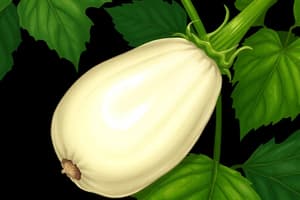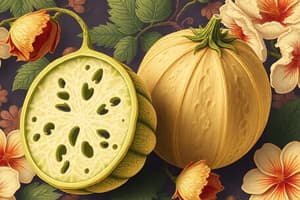Podcast
Questions and Answers
What is the primary use of Jatropha curcas oil?
What is the primary use of Jatropha curcas oil?
Which step directly follows the drying of harvested Jatropha curcas seeds in the oil extraction process?
Which step directly follows the drying of harvested Jatropha curcas seeds in the oil extraction process?
What is the primary residue left after oil extraction from Jatropha curcas seeds called?
What is the primary residue left after oil extraction from Jatropha curcas seeds called?
What additional product can Jatropha curcas oil be processed into apart from biodiesel?
What additional product can Jatropha curcas oil be processed into apart from biodiesel?
Signup and view all the answers
Which method is NOT mentioned as a way to extract oil from Jatropha curcas seeds?
Which method is NOT mentioned as a way to extract oil from Jatropha curcas seeds?
Signup and view all the answers
Which family does the jicama plant belong to?
Which family does the jicama plant belong to?
Signup and view all the answers
What type of plant is jicama classified as?
What type of plant is jicama classified as?
Signup and view all the answers
In which regions is jicama most widely cultivated?
In which regions is jicama most widely cultivated?
Signup and view all the answers
Where was jicama first domesticated?
Where was jicama first domesticated?
Signup and view all the answers
What part of the jicama plant is mainly utilized?
What part of the jicama plant is mainly utilized?
Signup and view all the answers
How is the tuberous root of jicama typically prepared?
How is the tuberous root of jicama typically prepared?
Signup and view all the answers
What is the status of jicama's growth cycle?
What is the status of jicama's growth cycle?
Signup and view all the answers
What type of plant is Jatropha curcas considered?
What type of plant is Jatropha curcas considered?
Signup and view all the answers
Study Notes
Jicama (Pachyrhizus erosus)
- Family: Fabaceae (Pea family)
-
Plant type:
- Herbaceous vine
- Herb
- Perennial
- Native distribution: Mexico and Central America
- Domestication: First domesticated in Mexico; archaeological finds in Peru date back to 3000 BC.
- Widely grown/used: Central America and Southeast Asia (introduced to Southeast Asia by the Spanish in the 17th century)
- Part used: Tuberous root (tap root system)
-
Processing:
- Harvest the root
- Peel the thin brown skin
- Cut into sticks, cubes, or slices (depending on use)
- Uses: Raw in salads, salsas, or snacks; cooked in stir-fries, soups, and stews.
Jatropha (Jatropha curcas)
- Family: Euphorbiaceae (Spurge family)
-
Plant type:
- Woody shrub (or small tree)
- Perennial
- Native distribution: American tropics (originating in Mexico and Central America, native to tropical areas of the Americas, from Mexico to Argentina.)
- Economic purpose: Oil production (biodiesel)
- Part used: Seeds
-
Processing:
- Harvest the seeds
- Dry the seeds
- Crush the seeds
- Press the seeds to extract oil
- Filter the oil
- Refine the oil (optional)
- Byproducts: Press cake (biomass for electricity or fertilizer)
- Oil uses: Fuel combustion engines, biodiesel, jet fuel, soap, glue, dye
Studying That Suits You
Use AI to generate personalized quizzes and flashcards to suit your learning preferences.
Description
Explore the characteristics and uses of Jicama and Jatropha, two important plants with diverse applications. Learn about their families, native distributions, and preparation methods. This quiz will enhance your understanding of these unique plants and their significance in various cuisines.




